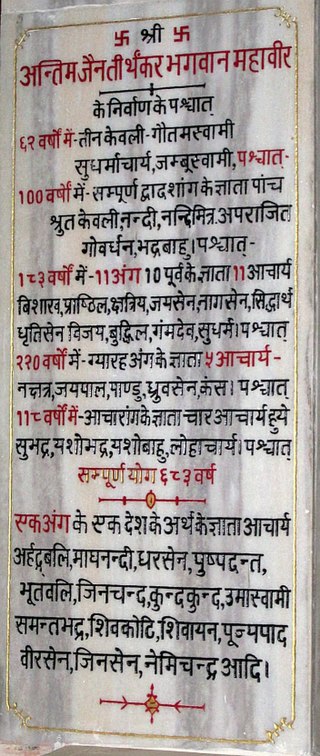Top Qs
Timeline
Chat
Perspective
Pattavali
Record of a spiritual lineage of heads of monastic orders From Wikipedia, the free encyclopedia
Remove ads
A Pattavali (From Sanskrit patta: seat, avali: chain), Sthaviravali or Theravali, is a record of a spiritual lineage of heads of monastic orders. They are thus spiritual genealogies.[1] It is generally presumed that two successive names are teacher and pupil. The term is applicable for all Indian religions, but is generally used for Jain monastic orders.

There are several famous pattavalis which are often used to establish historical chronologies:[2][3]
- Sarasvatigachchha Pattavali: Pattavali of the Balatkara Gana of Mula Sangh
- Tapagaccha Pattavali: Pattavali of Tapa Gachchha
- Upkeśa Gaccha Pattavali: Pattavali of the Upkeśa Gaccha (now extinct), the oldest of all pattavalis of the Jain sangha.[4][5]
- Kharataragachha Pattavali: Pattavali of Kharatara Gachchha
Glasenapp notes that although the chronological list mentioned in pattavali are valuable, it is not reliable.[6]
Remove ads
Description
Pattavali states the lineage of Jain monks.[7]
The Jain Monastic Lineages
Summarize
Perspective
According to 600 AD inscription at Sravanabelagola, Harivansha Purana, Jambuddvita Pannati and Kalpasutra, the Pattavali (lineage) after Mahavira, 24th tirthankara, until Bhadrabāhu is commonly recognized by both the sects without disputes. Differences arise from Sthulabhadra onwards, whose undisputed adherence to the Śvetāmbara is confirmed. [8] Kalpasutra gives a lineage starting with Pushyagiri after Vajrasena ending with Devardhi Ksamashramana, the president of the Vallabhi council under whom the principal canonical scriptures of the Śvetāmbara sect were formally written. The Kalpasutra also mentions ganas and shakhas established by other disciples of Bhadrabahu, Sambhutavijaya, Mahagiri etc. [9] The Brihat-Kharataragachchha pattavali gives the name of Chandra after Vajrasena, the lineage continues until Udyotana, the founder of Brihadgachcha.[10]
Apart from the given list, another list of preceptors of the Upkeśa Gaccha (now extinct) within the Śvetāmbara sect exists. While all other pattavalis trace their ancestry to the 24th Tirthankara Mahavira, Upkeśa Gaccha traces its ancestry to the 23rd Tirthankara Parshvanatha. [11] This pattavali, therefore, also supports the claim of the antiquity of the Śvetāmbara sect. Several eminent preceptors including Acharya Ratnaprabhasuri (founder of Oswal clan) and Acharya Swayamprabhasuri (founder of Porwal clan) belonged to the Upkeśa Gaccha.
- The Kevalis (those who attained kavalagyana)
- Mahavira Swami
- Gautam Swami
- Sudharmaswami (Lohacharya)
- Jambu Swami
- The Shruta Kevalis (who knew the complete oral texts) According to Digambara tradition:
- Vishnudeva
- Aparajita
- Govardhana
- Bhadrabahu
- The Shruta Kevalis (who knew the complete oral texts) According to Śvetāmbara tradition:
- Prabhava
- Sayyambhava
- Yashobhadra
- Sambhutavijaya
- Bhadrabahu
Remove ads
Digambara Lineage
According to Digambar tradition, the monastic lineage after Bhadrabāhu was:[12]
- Bhadrabahu, a shruta-kevalin
- Visakha, the 10-purvis begin here
- Prosthila
- Kshatria
- Jayasena
- Nagasena
- Siddhartha
- Dhritisena
- Vijaya
- Buddhilinga
- Deva I
- Dharasena
- Nakshatri, 11 angis begin here.
- Jayapalka
- Pandava
- Dhruvasena
- Kansa
- Subhadra, 1 angis begins here.
- Yashobhadra
- Bhadrabahu II
- Lohacarya II
- Arhadvali, ekangis with partial knowledge of one anga.
- Maghanandi
- Dharasena, see Satkhandagama
- Pushpadanta
- Bhutabali
Arhadvali is said to have been the founder of the divisions of the Mula Sangha. Even though the Digambara sect claims Manatunga was a Digambara monk, none of the pattavalis maintained by the Digambara sect mention him.
Śvetāmbara Lineage
Summarize
Perspective
According to the Śvetāmbara tradition, the monastic lineage is as follows: - [13]
- Sudharmaswami
- Jambu Swami
- Prabhava
- Sayyambhava
- Yashobhadra
- Sambhutavijaya & Bhadrabahu
- Sthulabhadra
- Mahagiri (268 BC to 168 BC) and Suhastin (222 BC to 122 BC)[14]
- Susthita and Supratibuddh
- Indradinna
- Dinna
- Sinhagiri
- Vajraswami (31 BC to 47 CE)[15]
- Vajrasena
- Chandrasuri
- Vriddhadeva
- Pradyotansuri
- Mandevsuri
- Mantungsuri - author of Bhaktāmara Stotra
- Virsuri
- Jaidevsuri
- Anandsuri
- Vikramsuri
- Narsimhsuriji
- Samudrasuri
- Mandevsuri II
- Vibudhprabhasuri
- Jayanandsuri
- Raviprabhsuri
- Yashodevsuri
- Pradyumnasuri
- Mandevsuri III
- Vimalchandrasuri
- Udyotansuri
- Sarvadevsuri
- Devsuri
- Sarvadevsuri II
- Yashobhadrasuri
- Munichandrasuri
- Vadidevsuri
- Vijaisinghsuri
- Somaprabhsuri
- Jagatchandrasuri - Founder of Tapagaccha
- Devendrasuri
- Vidyanandsuri and Dharmagoshsuri
- Somaprabhsuri
- Somatilaksuri
- Devsundersuri
- Somasundersuri
- Munisundersuri
- Ratnashekharsuri
- Lakshmisagarsuri
- Sumatisadhusuri
- Hemvimalsuri
- Anandvimalsuri
- Vijay Dansuri
- Vijay Hirsuri - One who inspired Akbar
- Vijaysen Suri
- Vijaydev suri
- Vijaysimhsuri
- Vijayprabhavsuri
- Satyavijay Gani
Another list of monks, of the preceptors of the Upkeśa Gaccha also exists and is considered to be an important pattavali as the creation of major Śvetāmbara clans such as Oswal, Porwal, and Srimal are connected to Upkeśa Gaccha.[4][5]
Remove ads
See also
Notes
References
Wikiwand - on
Seamless Wikipedia browsing. On steroids.
Remove ads
